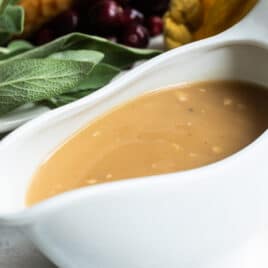Learn How to Make Gravy from Turkey Drippings. It’s luscious, lump-free, and perfect for drowning mashed potatoes, stuffing, and everything else on your plate.
An easy Turkey Gravy recipe is essential for the happiest Thanksgiving Feast. Pour it on your Turkey, Mashed Potatoes, and Stuffing, or perhaps just drown your plate in full.
I am sure we all get a sense of satisfaction from putting our leftover turkey drippings to work in gravy. It feels like the natural course of events and ensures the best possible tasting gravy.
If you have fresh broth on hand, you’ll level up your gravy even more. But if not, fear not. Your gravy will still be savory, luscious, and delicious.
With a cornstarch slurry as a thickener, this gravy is naturally (let’s say “accidentally”) gluten-free, in case you keep track of such things. But, you can use flour too.
When it’s time to start the gravy, before you carve the turkey, you’ll probably be finalizing a slew of side dishes. This gravy takes 10 to 20 minutes depending on how hot your drippings are, so it comes together fast. That’s definitely something to be thankful for!
At a Glance: Here is a quick snapshot of what ingredients are in this recipe. Please see the recipe card below for specific quantities.
Gravy is an essential component of many holiday meals, especially Thanksgiving. When made right, gravy can elevate an entire meal, tying all the flavors together beautifully. But when made wrong, gravy can be lumpy, greasy, and bland. The good news is that making great gravy from turkey drippings is easy, as long as you follow some simple steps. In this article, I’ll walk you through the entire process of making flawless gravy using the juices left behind after roasting your turkey.
Ingredients
- Turkey drippings (about 1/4 cup)
- Flour (about 1/4 cup)
- Chicken or turkey stock
- Whole milk or cream (optional)
- Salt and pepper
- Fresh thyme or sage (optional)
Step 1: Prepare the Drippings
After removing your roasted turkey from the pan pour the drippings into a fat separator or bowl. Allow the fat to rise and the drippings to settle. Skim off and discard most of the fat, reserving about 1/4 cup. Return the defatted drippings and 1/4 cup fat back to the roasting pan.
If you don’t have enough fat, supplement with butter. You want about 1/4 cup total since fat is necessary for a smooth gravy. Too little fat can result in a lumpy gravy.
Step 2: Make a Roux
Place the roasting pan with drippings over medium heat. Whisk in the flour, 1/4 cup at a time, until well blended. Continue cooking, whisking constantly, for 2-3 minutes. This flour-fat mixture is called a roux. Cook the roux until bubbly and deep golden brown for maximum flavor.
Step 3: Slowly Whisk in Liquid
Gradually whisk in 1 to 1 1/2 cups of chicken or turkey stock and bring to a boil, continuing to whisk constantly. Thin out the gravy with more stock or milk as needed, until desired consistency is reached. For a velvety richness, stir in 1/4 to 1/2 cup milk or cream.
Step 4: Simmer and Season
Reduce heat and let the gravy gently simmer for 5-10 minutes to cook off the raw flour taste. Season with salt pepper and fresh or dried herbs if desired.
For the best flavor, use unsalted or low-sodium stock and season more conservatively at first. You can always add more salt and pepper to taste.
Tip for Smoother Lumps-Free Gravy
- Use a wire whisk when incorporating the flour and gradually adding the liquid. This helps prevent lumps from forming.
- If lumps do form, press gravy through a fine mesh strainer before serving.
Tip for Richer, More Flavorful Gravy
- Use turkey wing tips and neck to make your own turkey stock, simmered with onions, carrots, and celery.
- Cook the roux to a deep brown for nutty notes without burning.
- Add aromatics like fresh or dried thyme, sage, parsley, or a bay leaf.
Serving Suggestions
A perfect gravy can make your Thanksgiving meal. Here are some delicious ways to use turkey gravy:
- Classic turkey and gravy with mashed potatoes and stuffing
- Biscuits and sausage gravy breakfast
- Turkey pot pie with drop biscuit topping
- Gravy over steamed vegetables like green beans
- Turkey and dumplings or noodles
- Shepherd’s pie with leftover turkey
- Use as sauce for turkey tetrazzini
With these simple steps, you’ll be ready to make the perfect gravy from your turkey drippings. Just remember to start with about 1/4 cup defatted drippings, whisk in flour to make a roux, slowly add liquid while whisking, simmer to thicken, and adjust seasonings. Now your gravy will be rich, smooth and full of flavor – an ideal finishing touch for your next holiday meal.

Recipe tips and variations
- Yield: This recipe makes about 6 cups gravy, enough for twelve (1/2-cup) servings.
- Storage: Store leftover turkey gravy in an airtight container in the refrigerator for up to 4 days.
- Browned bits = flavor: Make sure you get every last bit of the “fond,” the culinary term for the browned bits that cling to the pan after roasting.
- Make the slurry: Don’t skip the slurry. If you add dry cornstarch to hot liquid, it will clump.
- White wine: For a splash of acidity in the gravy, add a little bit of white wine.
- Chicken gravy: For chicken gravy, substitute pan drippings from a roasted chicken.
- Let the meat rest: Making gravy is the perfect thing to do while the turkey rests before carving. Keep it warm, and by the time the gravy is done, you’ll be ready to carve it up.
- Ultimate Turkey Guide: Cook your best Thanksgiving menu (or Sunday dinner) ever. Brush up on how to buy, thaw, brine, and cook a turkey, plus learn how easy it is to make turkey broth from bones and turkey gravy from pan drippings.

My recipe is written with cornstarch, but you can certainly substitute all-purpose flour. To substitute flour for the cornstarch, remove most of the fat from the roasting pan. Add the flour and cook, mixing with the drippings, until the raw flour smell disappears. Add the broth and scrape the bottom of the pan. No need to strain off the extra fat; just pour the gravy into a saucepan and continue with the recipe.
Flavor the gravy with a spirg or two of fresh herbs such as minced thyme, rosemary, sage, oregano, parsley or marjoram (or a ½ teaspoon dried). Add with the broth in step 2.
Both a roux and a slurry are used to thicken sauces. A roux contains fat and needs to be cooked. It gets added at the start of cooking. In contrast, a slurry doesn’t need any fat, goes into the sauce uncooked, and gets added at the end.
Giblets (pronounced with a soft “g” sound such as in “ginger”) are the inner organs of poultry or fowl such as heart, liver, and gizzards. They can be simmered with your drippings to make giblet gravy.
Chicken and Turkey Recipes

How to Make Gravy from Turkey Drippings | Thanksgiving Turkey Gravy | Turkey with Gravy | Easy Gravy
FAQ
How do you thicken turkey drippings for gravy?
How do you separate the fat from turkey drippings for gravy?
What to do with turkey fat drippings?
How do you turn liquid into gravy?
